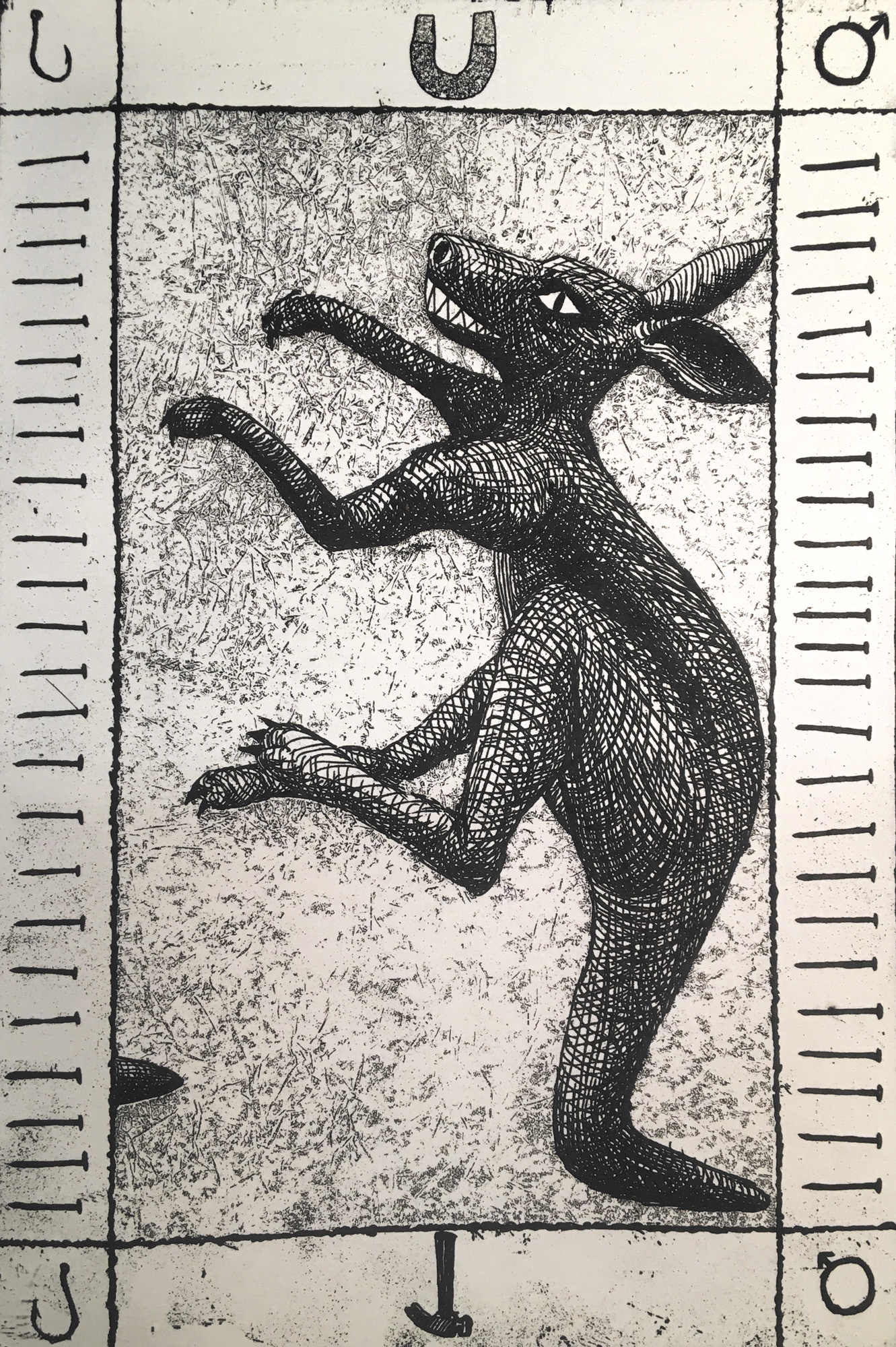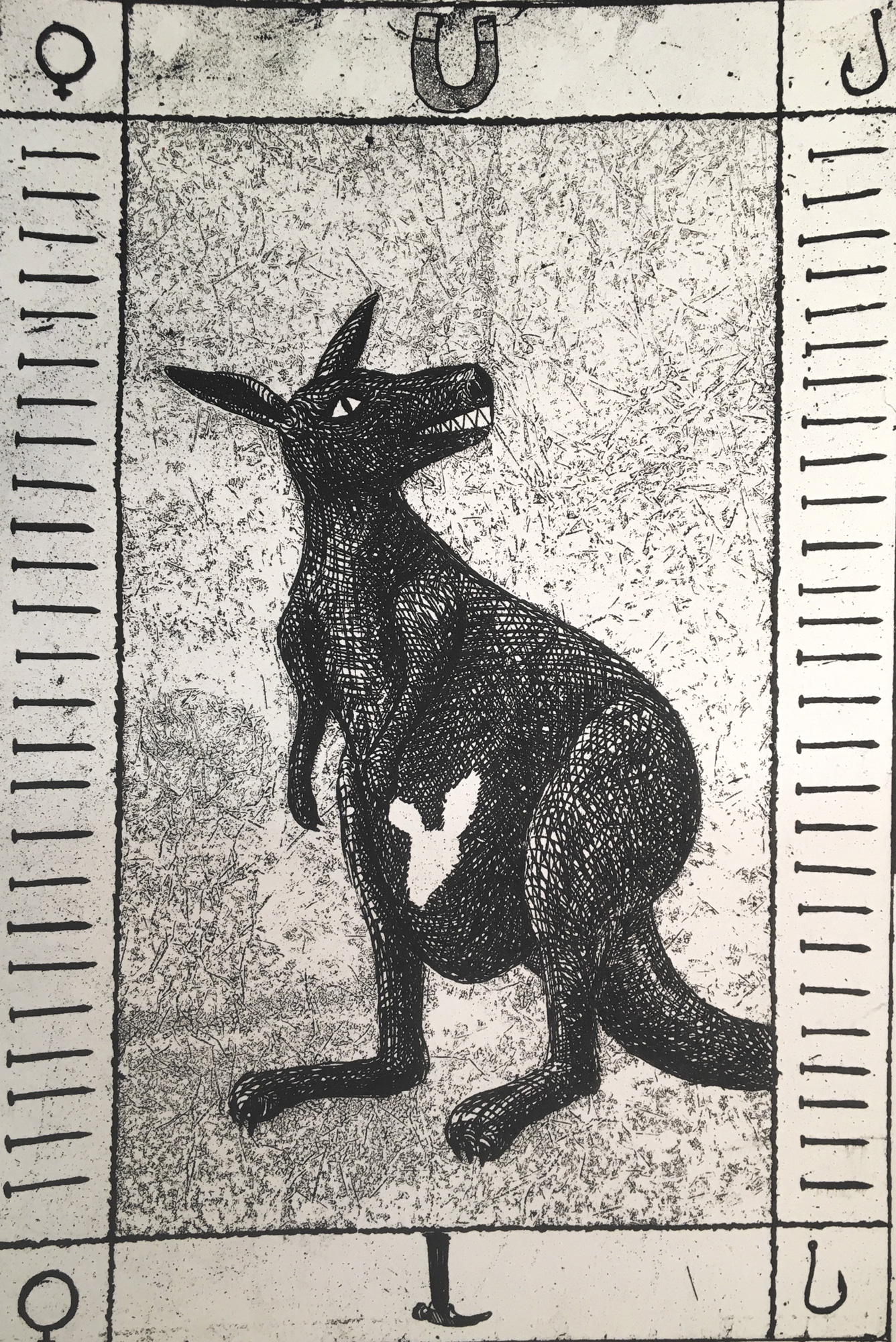
Kangwolf Roodar
Too Spin Me Round (Like A Macropod)
By Nate Balding
Art by Grant Williams
Published Issue 095, November 2021
It’s been said that the only thing to fear is fear itself. It’s also been said that one should never enter into unarmed combat with a kangaroo. Both can be true but only one is actually a notable piece of advice.
The kangaroo one.
Any given Crocodile Dundee can tell you that kangaroos are the most jacked and therefore the most formidable animals from phylum Boxing Glove. But they will also say you’re safe as long as you never, ever — ever ever ever — go to Australia. And they’d be dead wrong.
Phantom kangaroos have haunted the American Midwest for over a century. Coon Rapids, Minnesota experienced a full decade of kangaroo malfeasance originating in the woods near the Anoka County Fairground. Some say they were the product of a carnal experience between a 4-H stable and a sentient ring toss game. More reasonable people have theorized they were missing members of a zoological oddity attraction. Truly, who’s to say.
From 1957 to 1967 residents of Coon Rapids witnessed the roving leapers often enough to term them colloquially as “The Big Bunnies,” typically spotted in multitudes rummaging through backyard detritus. How they failed to immediately go with a raccoon knocking over trash cans comparison is unknown but, given the era, we’re once again offered an opportunity to simply baseline fault “The War.”

The kangaroos disappeared from Minnesota after their brief reign of benign terror but started showing up across middle America sporadically up until the 2000s. In 1974 a kangaroo was found lounging on a porch in Chicago. Police were called and, after taking a humorous double take and tossing a half-full flask into the gutter, gave chase. The kangaroo, having not recently spent a lifetime eating tubed meats and deep-dish, outran them and leapt over a high wall at the end of a blind alley. Over the next several months kangaroo sightings in the city and surrounding areas rose. The bouncing beasts were spotted as far away as Plano, Illinois and Menomonee Falls, Wisconsin where, in 1978, two men grabbed a quick photo of a creature jumping across the highway. Famed Cryptozoologist Loren Coleman believed it to be a Bennett’s Wallaby, possibly escaped from the Cincinnati Zoo.
In 1980 the kangaroos, sick of the Minnesota winters, did what Americans have been doing forever and headed west to begin their haunt of San Francisco. Rumors about ghostly monsters presenting with glowing eyes and mysterious jumping capabilities living in Golden Gate Park spread. A hit and run accident in 1981 involving a kangaroo-like creature was observed and reported though neither the driver nor the corpsearoo could be found afterward, giving credence to the idea that these animals had transcended the liminal space of corporeality and become actual phantoms. This was in Golden Gate Park, however; a place where purchasing LSD has never not been an option, so these claims may be taken with a grain of great exaggeration.
Typical of the American family, not everyone made it out west. Some of the kangaroos — perhaps those with undesirable political stances — stayed in Wisconsin. In 2005 Dodgeville, WI had a series of sightings. Somebody correctly resolved to (instead of calling Animal Control) assemble a search party and hit the trails. The posse tracked the kangaroo to a barn on a horse farm. Horses, being notorious snitches, outed the marsupial and offered to turn state’s evidence. But rather than pursuing charges, the kangaroo was remanded to the Henry Vilas Zoo in Madison where it lived out the remainder of its days without seeing due process. He’s remembered with a statue installed in 2008 in the children’s play area.
Despite a lengthy inquiry following the Dodgeville incident nobody has managed to figure out how these kangaroos came to exist halfway across the world and on the wrong side of the international dateline. But there’s no doubt that they’re out there in the woods doing overly stable triple jump TikTok challenges that humans were never supposed to know about unless they’re, like, cool or whatever.
Have questions about the paranormal?
Send them to werewolfradarpod@gmail.com or on Twitter: @WerewolfRadar.
It’s a big, weird world. Don’t be scared. Be Prepared.
Nate Balding is a freelance humanoid who occasionally manifests in print and can most likely be seen at Werewolf Radar. Should you wish to hear him manifest audibly you can do so at the aforementioned Werewolf Radar’s associated podcast on Spotify andApple, and if anything ever becomes humorous again, on a variety of stand up stages around the nation. If you’re truly craving further content there’s always @Exploder on Twitter — even if it is only a form of digital self flagellation at this point. His one thing that he considers actually accomplished was this time he was published in the journal Nature and then later collected into a volume called Futures from Nature, still available in places that have things.
In case you missed it, check out Nate’s October Werewolf Radar, Scarewolf Craydar: Cat’s In the Cradle, A Cautionary Tale, or head to Explore to see more installations.
Grant Williams is a Denver-based artist who has been working out of Blue Silo Studios for over a decade. He graduated with a BFA in printmaking from the University of Denver in 1991. Since that time he has worked and shown across the Front Range and elsewhere. His work consists largely of etchings, but he also shown drawings, paintings, and sculptures. He has been published in several magazines, and done book illustration work.
Check out Grant’s last Birdy contribution, Home, the inspiration for Joel Tagert’s short story, OnlyFae.
